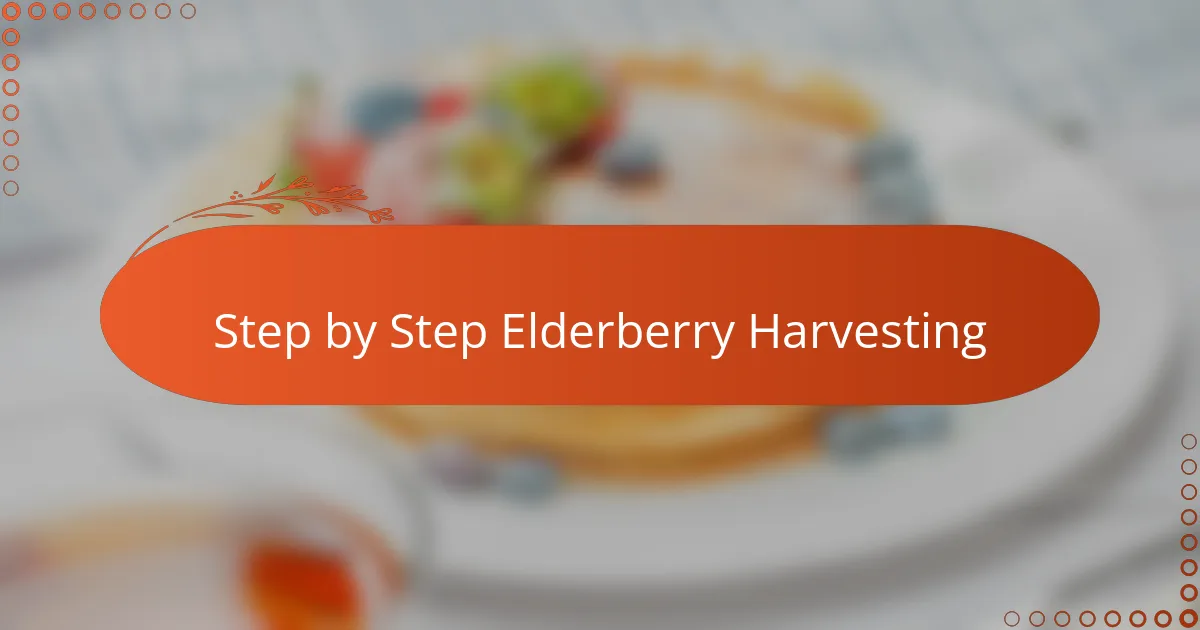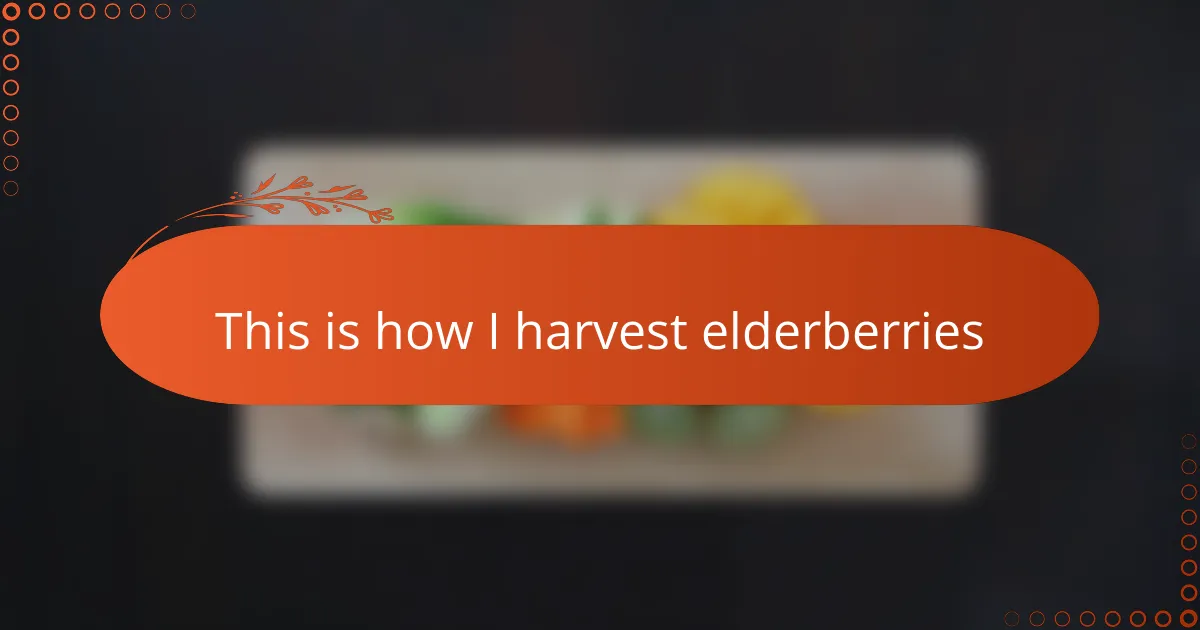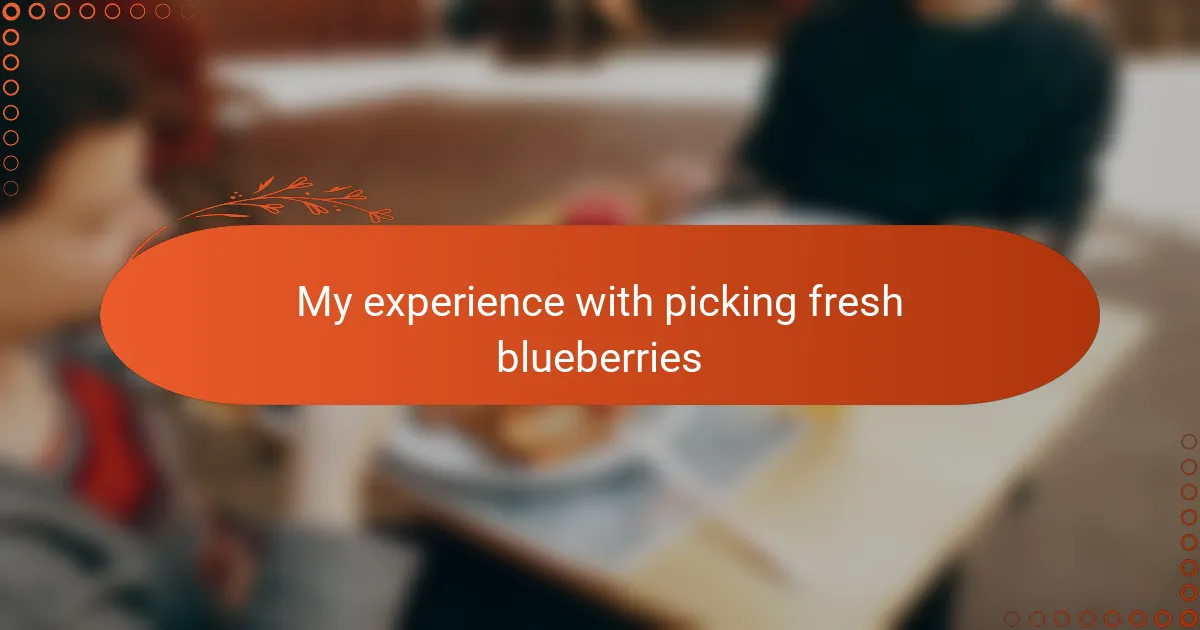Key takeaways
- Harvest elderberries only when fully ripe, as unripe ones can be bitter and mildly toxic.
- Use appropriate tools like pruning shears and gloves to ensure safe and efficient harvesting.
- Timing is crucial; the best harvest occurs in late summer to early fall for optimal flavor.
- Handle berries gently and wash them right before use to maintain freshness and prevent mushiness.

Understanding Elderberries Harvesting
Harvesting elderberries is an art that demands both patience and care. Have you ever noticed how the clusters of tiny, deep purple berries almost seem to call out when they’re ripe? I remember my first time picking elderberries—those moments of reaching into the bush, knowing that timing is everything, made the whole experience feel almost magical.
One key thing I’ve learned is to wait until the berries are fully ripe; unripe elderberries can be quite bitter and even mildly toxic if consumed raw. This taught me to pay close attention to the color and texture—only the plump, dark berries make the cut. It’s a simple detail but makes all the difference in flavor and safety.
I also think about the connection to the land when I harvest elderberries. These bushes often grow wild and free, and taking from them responsibly means leaving enough for the birds and native wildlife. Isn’t it amazing how this small act of harvesting ties you into a larger cycle of nature? That awareness makes the berries taste all the sweeter in my kitchen.

Preparing for Elderberry Picking
Before heading out to pick elderberries, I always make sure to dress appropriately—long sleeves and gloves are a must to protect against the thorny branches and any pesky insects. Have you experienced that scratchy feeling when you underestimate these bushes? Trust me, a little preparation spares you the discomfort.
I also bring a sturdy container that allows the delicate berries to breathe and stay intact. Early on, I learned that squashing the elderberries ruins their flavor and makes the whole batch harder to clean. It’s those small practical details that save time and frustration later.
Finally, I take a moment to scout the bushes for signs of ripeness and accessibility. Sometimes the best clusters hide deep inside or at awkward angles—have you ever had to do a little acrobatics to reach the perfect berry? It’s part of the fun and what makes the harvest feel like a rewarding treasure hunt.

Best Time to Harvest Elderberries
Timing the harvest is everything with elderberries. I’ve found that the best time to pick is late summer to early fall, usually around August and September, when the berries turn a rich, dark purple. It’s hard to resist reaching for a bunch just as they start to change color, but patience is key—it’s worth waiting for that deep hue that signals full ripeness.
I remember one season when I got a little impatient and tried picking some berries too early. The taste was bland and slightly unpleasant, reminding me why you should never rush this process. It made me appreciate how significant those subtle changes in color and softness are in deciding the perfect harvest time.
Have you ever wondered how the weather affects elderberry ripening? From my experience, a warm, sunny stretch speeds things up, while rainy or cool spells slow it down. Paying attention to these cues allowed me to plan better and return just when the berries were at their peak flavor and nutrition.

Tools Needed for Elderberry Harvesting
When I first started harvesting elderberries, I quickly realized that having the right tools makes all the difference. A pair of sharp pruning shears became my best friend—they help snip those delicate clusters cleanly without damaging the plant or crushing the berries. Have you ever tried pulling them off by hand? It usually ends with a mess and bruised fruit.
I also always carry a bucket with a handle, something sturdy but not too heavy. It makes gathering and carrying the harvest so much easier, especially when you find yourself reaching for multiple bushes in one outing. Plus, a soft cloth or an old T-shirt tucked in the bucket can help cushion the berries and prevent them from smashing.
Gloves are another tool I won’t leave home without. Elderberry bushes often have small thorns or rough branches that can scratch or irritate your skin if you’re not careful. I’ve learned the hard way—once, after a long afternoon picking without gloves, I ended up with itchy red marks that lasted days. It’s a simple step that keeps the experience enjoyable rather than painful.

Step by Step Elderberry Harvesting
The first step I take when harvesting elderberries is to gently cut the entire cluster from the branch using pruning shears. Have you ever tried to pick berries one by one? It quickly becomes frustrating and risks bruising the fruit, so clipping whole bunches keeps them intact and fresh.
Once I have the clusters, I carefully place them in my container, making sure not to overcrowd and crush the berries underneath. I remember learning this the hard way—one harvest where I piled too many berries resulted in a messy purple stain and squashed fruit, which wasn’t ideal for my recipes.
Finally, before heading back inside, I do a quick scan of the bush to see if I missed any ripe clusters, sometimes hidden in the shadows or deep within the foliage. It feels like a little treasure hunt every time, and finding those late berries always brings a smile to my face.

Safe Handling of Elderberries
Handling elderberries safely has been a crucial lesson in my elderberry journey. Did you know that raw elderberries, especially their stems and leaves, contain compounds that can upset your stomach or worse? That little fact made me extra careful to strip every berry clean from its tiny green stems before using them.
When I first started, I made the mistake of washing the berries too early, causing them to become mushy and lose flavor. Now, I only wash them right before cooking or freezing, which keeps their taste vibrant and their texture just right. Have you ever tried washing delicate berries too soon? It’s a tender balance between cleanliness and preserving freshness.
Also, wearing gloves during handling isn’t just about protection from thorny branches; elderberry sap can sometimes cause mild skin irritation. Once, after a long picking day without gloves, I noticed my hands itching—definitely a lesson learned. Taking these small precautions ensures the harvest remains a joyful, safe ritual rather than a risky chore.

Personal Tips for Elderberry Harvesting
One thing I’ve found helpful is to pick elderberries on a dry day. Have you ever tried harvesting right after rain? The berries can be slippery and more prone to mold if stored damp. Waiting for a sunny morning means the berries are firm and less likely to spoil quickly.
I usually harvest elderberries by cutting whole clusters rather than plucking individual berries. It’s quicker and helps avoid squishing the delicate fruit. Early on, I learned this the hard way after crushing half my haul in an attempt to be “precise”—lesson learned, less is more when it comes to handling these little gems.
And here’s a tip I didn’t expect: don’t rush the process. Sometimes, the perfect clusters hide in tricky spots that require a bit of stretching or bending. Have you ever felt that small thrill of finally reaching the best bunch? It’s those moments that make elderberry picking feel like a little reward for your patience.



